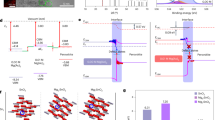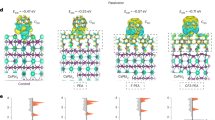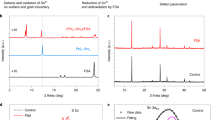Abstract
All-inorganic perovskites prepared by substituting the organic cations (for example, methylammonium and formamidinium) with inorganic cations (for example, Cs+) are effective concepts to enhance the long-term photostability and thermal stability of perovskite solar cells (PSCs)1,2. Hence, inorganic perovskite tandem solar cells (IPTSCs) are promising candidates for breaking the efficiency bottleneck and addressing the stability issue, too3,4. However, challenges remain in fabricating two-terminal (2T) IPTSCs due to the inferior film formation and deep trap states induced by tin cations5,6,7. Here a ligand evolution (LE) strategy with p-toluenesulfonyl hydrazide (PTSH) is used to regulate film formation and eliminate deep traps in inorganic narrow-bandgap (NBG) perovskites, enabling the successful development of 2T IPTSCs. Accordingly, the 1.31 eV CsPb0.4Sn0.6I3:LE device delivers a record efficiency of 17.41%. Combined with the 1.92 eV CsPbI2Br top cell, 2T IPTSCs exhibit a champion efficiency of 22.57% (certified, 21.92%). Moreover, IPTSCs are engineered to deliver remarkable durability under maximum power point (MPP) tracking, maintaining 80% of their initial efficiency at 65 °C for 1,510 h and at 85 °C for 800 h. We elucidate that LE deliberately leverages multiple roles for inorganic NBG perovskite growth and anticipate that our study provides an insightful guideline for developing high-efficiency and stable IPTSCs.
This is a preview of subscription content, access via your institution
Access options
Access Nature and 54 other Nature Portfolio journals
Get Nature+, our best-value online-access subscription
27,99 € / 30 days
cancel any time
Subscribe to this journal
Receive 51 print issues and online access
199,00 € per year
only 3,90 € per issue
Buy this article
- Purchase on SpringerLink
- Instant access to full article PDF
Prices may be subject to local taxes which are calculated during checkout




Similar content being viewed by others
Data availability
The data that support the findings of this study are available from the corresponding author upon reasonable request. Source data are provided with this paper.
References
Bai, S. et al. Planar perovskite solar cells with long-term stability using ionic liquid additives. Nature 571, 245–250 (2019).
Li, Z. Z. et al. Approaches for thermodynamically stabilized CsPbI3 solar cells. Nano Energy 71, 104634 (2020).
He, R. et al. Wide-bandgap organic–inorganic hybrid and all-inorganic perovskite solar cells and their application in all-perovskite tandem solar cells. Energy Environ. Sci. 14, 5723–5759 (2021).
Sun, Q. et al. Integrated 4-terminal all-inorganic perovskite tandem solar cell with open-circuit voltage exceeding 2.1 V for water splitting. ACS Energy Lett. 7, 4215–4223 (2022).
Chen, G. et al. Design of low bandgap CsPb1−xSnxI2Br perovskite solar cells with excellent phase stability. Small 17, 2101380 (2021).
Ye, T. et al. Localized electron density engineering for stabilized B-γ CsSnI3-based perovskite solar cells with efficiencies >10%. ACS Energy Lett. 6, 1480–1489 (2021).
Duan, C. et al. A bifunctional carbazide additive for durable CsSnI3 perovskite solar cells. Adv. Mater. 35, 2300503 (2023).
Lin, R. et al. All-perovskite tandem solar cells with 3D/3D bilayer perovskite heterojunction. Nature 620, 994–1000 (2023).
Wang, Z. et al. Suppressed phase segregation for triple-junction perovskite solar cells. Nature 618, 74–79 (2023).
Green, M. A. et al. Solar cell efficiency tables (version 64). Prog. Photovolt. 32, 425–441 (2024).
Chu, X. et al. Surface in situ reconstruction of inorganic perovskite films enabling long carrier lifetimes and solar cells with 21% efficiency. Nat. Energy 8, 372–380 (2023).
Zhang, H. et al. Tailored cysteine-derived molecular structures towards efficient and stable inorganic perovskite solar cells. Adv. Mater. 35, 2301140 (2023).
Liu, C. et al. Soft template-controlled growth of high-quality CsPbI3 films for efficient and stable solar cells. Adv. Energy Mater. 10, 1903751 (2020).
Hu, M. et al. Surface Sn(iv) hydrolysis improves inorganic Sn−Pb perovskite solar cells. ACS Energy Lett. 8, 1035–1041 (2023).
Wang, C. et al. Low‐bandgap mixed tin‐lead perovskites and their applications in all‐perovskite tandem solar cells. Adv. Funct. Mater. 29, 1808801 (2019).
Gu, S. et al. Tin and mixed lead-tin halide perovskite solar cells: progress and their application in tandem solar cells. Adv. Mater. 32, 1907392 (2020).
Wen, Q. et al. All-inorganic CsPb1–xSnxI2Br perovskites mediated by dicyandiamide additive for efficient 4-terminal tandem solar cell. Chem. Eng. J. 452, 139697 (2023).
Li, Q. et al. Unlocking the myths of molecular bonding state in modulating oxidation and Anderson localization for inorganic Sn/Pb‐based perovskite solar cells. Adv. Energy Mater. 14, 2401114 (2024).
Hu, M. et al. Antioxidative solution processing yields exceptional Sn(ii) stability for sub-1.4 eV bandgap inorganic perovskite solar cells. J. Energy Chem. 72, 487–494 (2022).
Yeom, K.-W. et al. Hard and soft acid and base (HSAB) engineering for efficient and stable Sn-Pb perovskite solar cells. Adv. Energy Mater. 12, 2202496 (2022).
Zhu, H. et al. Low-dimensional Sn-based perovskites: evolution and future prospects of solar cells. Chem 8, 2939–2960 (2022).
Song, T.-B. et al. Importance of reducing vapor atmosphere in the fabrication of tin-based perovskite solar cells. J. Am. Chem. Soc. 139, 836–842 (2017).
Zhang, Z. et al. Perovskite-based tandem solar cells: get the most out of the Sun. Adv. Funct. Mater. 30, 2001904 (2020).
Duan, C. et al. Improving the stability and scalability of all-inorganic inverted CsPbI2Br perovskite solar cell. J. Energy Chem. 68, 176–183 (2022).
Sutton, R. J. et al. Cubic or orthorhombic? Revealing the crystal structure of metastable black-phase CsPbI3 by theory and experiment. ACS Energy Lett. 3, 1787–1794 (2018).
Chen, B. et al. In situ observing and tuning the crystal orientation of two-dimensional layered perovskite via the chlorine additive. Nano Lett. 22, 7826–7833 (2022).
Wang, J. et al. Controlling the crystallization kinetics of lead-free tin halide perovskites for high performance green photovoltaics. Adv. Energy Mater. 11, 2102131 (2021).
Liu, J. et al. Mechanistic investigation of the enhanced NH3-SCR on cobalt-decorated Ce-Ti mixed oxide: in situ FTIR analysis for structure-activity correlation. Appl. Catal. B 200, 297–308 (2017).
Diaz, J. R. A. et al. A substituted sulfonamide and its Co (ii), Cu (ii), and Zn (ii) complexes as potential antifungal agents. J. Enzyme Inhib. Med. Chem. 31, 51–62 (2016).
Lin, Z. et al. Preparation of efficient inverted tin-based perovskite solar cells via the bidentate coordination effect of 8-hydroxyquinoline. Chem. Commun. 56, 4007 (2020).
Lee, S. J. et al. Fabrication of efficient formamidinium tin iodide perovskite solar cells through SnF2–pyrazine complex. J. Am. Chem. Soc. 138, 3974–3977 (2016).
Kajal, S. et al. Coordination modulated passivation for stable organic-inorganic perovskite solar cells. Chem. Eng. J. 451, 138740 (2023).
Gong, X. et al. Controllable perovskite crystallization by water additive for high‐performance solar cells. Adv. Funct. Mater. 25, 6671–6678 (2015).
Gao, Y. et al. Boosting performance of CsPbI3 perovskite solar cells via the synergy of hydroiodic acid and deionized water. Adv. Energy Sust. Res. 3, 2100149 (2022).
Huang, J. et al. Impact of H2O on organic–inorganic hybrid perovskite solar cells. Energy Environ. Sci. 10, 2284–2311 (2017).
Eperon, G. E. et al. Perovskite-perovskite tandem photovoltaics with optimized band gaps. Science 354, 861–865 (2016).
McMeekin, D. P. et al. Solution-processed all-perovskite multi-junction solar cells. Joule 3, 387–401 (2019).
Xu, T. et al. Interface modification for efficient and stable inverted inorganic perovskite solar cells. Adv. Mater. 35, 2303346 (2023).
Zhao, X. et al. Accelerated aging of all-inorganic, interface-stabilized perovskite solar cells. Science 377, 307–310 (2022).
Lee, S.-U. et al. Atomic layer deposition of SnO2 using hydrogen peroxide improves the efficiency and stability of perovskite solar cells. Nanoscale 15, 5044–5052 (2023).
Acknowledgements
This work was supported in part by funds from the National Natural Science Foundation of China (U2001217), Guangdong Science and Technology Program (2019ZT08L075, 2019QN01L118 and 2024A1515011154), National Key Research and Development Program of China (2022YFB3803300), the International Training Program for Young Talents of Guangdong Province and Guangzhou Science and Technology Planning Project (2023A04J1697) and Zhejiang Jusheng Solar S&T (2023440002001153).
Author information
Authors and Affiliations
Contributions
K.Y. conceived the idea and directed the overall project. C.J.B., F.G., F.W., X.L. and N.L. supervised the research. K.Z., Z.P. and L.D. revised the manuscript. C.D. performed the main experiments and drafted the manuscript. S.L. and X.L. carried out the GIWAXS measurement and analysis. J.Q. carried out the TOF-SIMS measurement. F.Z. and Q.Z. fabricated the NBG perovskite films. C.C. prepared the WBG perovskite films. J.L. carried out the SEM and X-ray diffraction characterizations. Z.Z. performed the photoluminescence and time-resolved photoluminescence analysis of perovskite films.
Corresponding author
Ethics declarations
Competing interests
The authors declare no competing interests.
Peer review
Peer review information
Nature thanks Michael Saliba, Qingwen Tian and Yiqiang Zhang for their contribution to the peer review of this work. Peer reviewer reports are available.
Additional information
Publisher’s note Springer Nature remains neutral with regard to jurisdictional claims in published maps and institutional affiliations.
Extended data figures and tables
Extended Data Fig. 1 In situ characterization for film growth.
2D contour maps of in-situ UV-vis spectra of (a) CsPb0.4Sn0.6I3 and (b) CsPb0.4Sn0.6I3:PTSH perovskite film during the annealing process at 70 °C. 2D contour maps of in-situ XRD spectra of (c) CsPb0.4Sn0.6I3 and (d) CsPb0.4Sn0.6I3:PTSH perovskite film during the annealing process at 70 °C.
Extended Data Fig. 2 DFT simulation on the coordination.
The binding energies (BE) between DMSO or PTSH molecules and PbI2 or SnI2, respectively. Where white, brown, light blue, red, yellow, ice blue, and black balls are H, C, N, O, S, Sn, and Pb atoms. The BE of PTSH molecules with Sn2+ for SnI2 and Pb2+ for PbI2 are −2.112 eV and −1.817 eV, respectively, which are higher than the binding energies of DMSO molecules with Sn2+ for SnI2 (−1.613 eV) and Pb2+ for PbI2 (−1.434 eV).
Extended Data Fig. 3 Identification of gas products of LE.
(a) Diagram of the gas collection process. (b) Photographs of CuSO4 powder color change. (c) Photographs of the color change of purple litmus reagent in bottle 1, and the color change of H2O2 solution and starch solution in bottle 1 successively. (d) Photographs of Mg burning in bottle 2, and the color change of litmus paper caused by the gas produced after adding hot water.
Extended Data Fig. 4 ToF-SIMS measurements.
ToF-SIMS of depth profiles of anion distribution in inorganic (a) CsPb0.4Sn0.6I3, (b) CsPb0.4Sn0.6I3:LE and (c) CsPb0.4Sn0.6I3:LE based on ALD-SnO2 PSCs with continuous illumination at 85 °C for 10 days in N2 glovebox.
Supplementary information
Supplementary Information
Supplementary Notes 1–3, Figs. 1–60, Tables 1–9, Schemes 1 and 2 and references.
Rights and permissions
Springer Nature or its licensor (e.g. a society or other partner) holds exclusive rights to this article under a publishing agreement with the author(s) or other rightsholder(s); author self-archiving of the accepted manuscript version of this article is solely governed by the terms of such publishing agreement and applicable law.
About this article
Cite this article
Duan, C., Zhang, K., Peng, Z. et al. Durable all-inorganic perovskite tandem photovoltaics. Nature 637, 1111–1117 (2025). https://doi.org/10.1038/s41586-024-08432-7
Received:
Accepted:
Published:
Issue Date:
DOI: https://doi.org/10.1038/s41586-024-08432-7
This article is cited by
-
Present status of and future opportunities for all-perovskite tandem photovoltaics
Nature Energy (2025)
-
Highlights of mainstream solar cell efficiencies in 2024
Frontiers in Energy (2025)
-
Buried Interface Regulation with TbCl3 for Highly-Efficient All-Inorganic Perovskite/Silicon Tandem Solar Cells
Nano-Micro Letters (2025)



